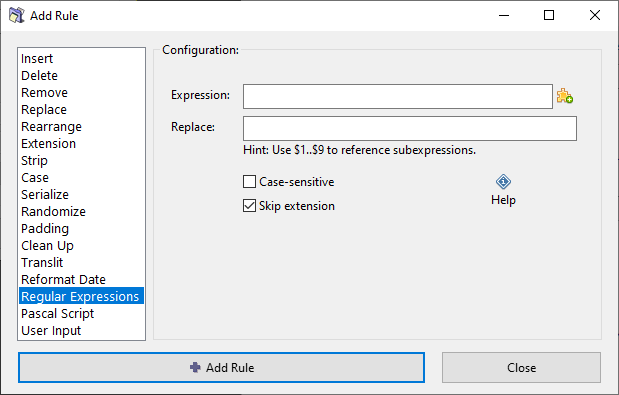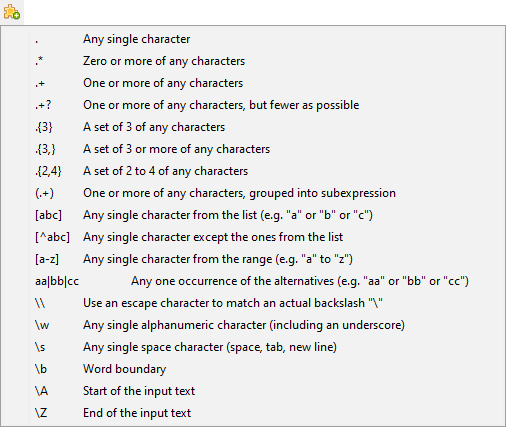ReNamer:Rules:RegEx: Difference between revisions
Jump to navigation
Jump to search
(Added "BackReference explanations") |
(Left align the rule image) |
||
| (3 intermediate revisions by the same user not shown) | |||
| Line 1: | Line 1: | ||
{{DISPLAYTITLE:ReNamer › Rules › Regular Expressions rule}} | |||
{{Go|up=ReNamer:Rules|prev=ReNamer:Rules:Translit|next=ReNamer:Rules:PascalScript}} | {{Go|up=ReNamer:Rules|prev=ReNamer:Rules:Translit|next=ReNamer:Rules:PascalScript}} | ||
[[Image:RegExRule.png | [[Image:RegExRule.png]] | ||
This rule | This rule allows finding and replacing patterns defined as [[ReNamer:Regular Expressions|Regular Expressions]]. | ||
''' | Regular Expressions (RegEx) use a special syntax for describing search and replace patterns, they are very powerful and ''really'' worth learning. | ||
ReNamer users have posted many RegEx examples at the [http://www.den4b.com/forum/ User Forum], where you might find your particular case already solved. | |||
'''Note:''' The RegEx engine used in ReNamer is a little different from the mainstream [http://perldoc.perl.org/perlre.html PERL RegEx] or [http://msdn.microsoft.com/en-us/library/6wzad2b2(VS.85).aspx Windows RegEx]. You can check the syntax in the [[ReNamer:Regular Expressions|Regular Expressions]] article. | |||
The parameters are as follows: | The parameters are as follows: | ||
| Line 31: | Line 36: | ||
[[File:RegExRuleSyntaxHint.png]] | [[File:RegExRuleSyntaxHint.png]] | ||
[[Category:ReNamer]] | [[Category:ReNamer]] | ||
Latest revision as of 12:35, 17 April 2025
This rule allows finding and replacing patterns defined as Regular Expressions.
Regular Expressions (RegEx) use a special syntax for describing search and replace patterns, they are very powerful and really worth learning.
ReNamer users have posted many RegEx examples at the User Forum, where you might find your particular case already solved.
Note: The RegEx engine used in ReNamer is a little different from the mainstream PERL RegEx or Windows RegEx. You can check the syntax in the Regular Expressions article.
The parameters are as follows:
| Parameter | Details |
|---|---|
| Expression | RegEx pattern to match or find. |
| Replace | RegEx pattern that replaces the found pattern. |
| Skip extension | If this check box is selected, the extension will be ignored by the rule. |
| Case-sensitive | If this option is selected, ReNamer will search for the text in case-sensitive manner. |
A simple set of commonly used RegEx syntax patterns is provided in the hint menu:

